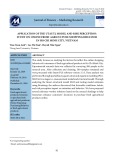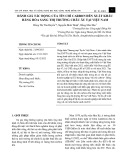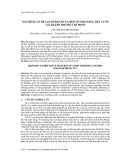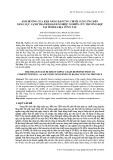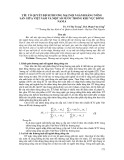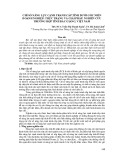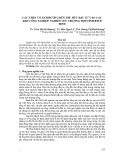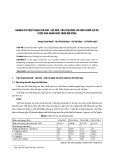
VNU Journal of Science: Economics and Business, Vol. 36, No. 2 (2020) 13-25
13
Original Article
Comparison of the Capital Asset Pricing Model
and the Three-Factor Model in a Business Cycle:
Empirical Evidence from the Vietnamese Stock Market
Luong Tram Anh*
VNU University of Economics and Business, Vietnam National University, Hanoi,
144 Xuan Thuy, Cau Giay, Hanoi, Vietnan
Received 6 November 2019
Revised 09 June 2020; Accepted 15 June 2020
Abstract: Using data from 2010 to 2019, for the first time, the Capital Asset Pricing Model
(CAPM) and the Three-factor Model (TFM) are compared in different contexts of the Vietnamese
economy (recession and recovery). This paper employs four tests including the t-test,
determination coefficient R2, Chow-test and GRS-test to examine the performance of the two
models. Results show the superiority of the TFM over the CAPM in both contexts of the economy,
consistent with Fama and French’s studies. This promises that the TFM can be used to replace the
CAPM in capturing the cost of equity. Another finding is that the two models tend to perform
better in recession than recovery. This study contributes to the literature about asset-pricing models
and their performances in different economic contexts. Moreover, the findings also offer insights
into the use of the CAPM and TFM in developing countries in general and Vietnam, in particular.
Keywords: Capital asset pricing model, three-factor model, business cycle, developing countries.
1. Introduction *
1.1. The Capital Asset Pricing Model (CAPM)
and Fama-French Three-Factor Model (TFM)
The return is a fundamental factor that
affects investment decisions on the stock
market. There are many asset-pricing models to
_______
* Corresponding author.
E-mail address: tramanh@vnu.edu.vn
https://doi.org/10.25073/2588-1108/vnueab.4298
determine the variation in stock returns such as
the APT model, Capital Asset Pricing Model
(CAPM) and Fama-French Three-factor Model
(TFM). One of the most important models is the
CAPM. Being first introduced by Sharpe (1964)
and then developed by Lintner (1965) and
Jensen (1968), the CAPM has become one of
the most popular asset-pricing models that
address the risk-return trade off. Assumptions
of this model are summarized as follows [1]:

L.T. Anh / VNU Journal of Science: Economics and Business, Vol. 36, No. 2 (2020) 13-25
14
i) “Mean-variance-efficiency”: All investors
make decisions depending on risk and expected
returns only.
ii) Homogeneity of investor expectations:
All investors have the same beliefs in
investments (the expected values and the
variance of expected returns).
iii) All investors can borrow and lend any
risk-free assets and any risky securities
regardless of the amount they borrow or lend.
iv) Capital markets are perfectly
competitive. No transaction costs and taxes
regardless of investors’ investment and
transactions.
v) All transactions are made at a certain time.
( ( ) (1)
j f i j M f i
E R R E R R
Where αi = the intercept of regression,
βi = the slope of regression, εi = the random
error;
M
R
= returns on the market, Rf = free-
risk return. In the test of the effectiveness of the
CAPM, Fama and French (1992) observed the
rate of returns on New York Stock Exchange
(NYSE) stocks and concluded that this model
could not explain returns between 1941 and
1990, especially between 1963 and 1990 [2].
Besides the risk premium, they added two other
factors that influenced returns: the size (ME)
and the book-to-market equity (BE/ME) of a
company. Thus, the return was explained by
three factors and the Fama-French model is:
E(Ri) – Rf = αi + βi[E(RM) – Rf] + siSMB +
hiHML + εi (2)
Where βi, si and hi = the slopes in the time-
series regression; εi = mean-zero regression
disturbance; SMB (Small Minus Big) = 1/3
(Small Value + Small Neutral + Small Growth)
- 1/3 (Big Value + Big Neutral + Big Growth)
(This is the average return on three small
portfolios minus the average return on three big
portfolios); HML (High Minus Low) = 1/2
(Small Value + Big Value) - 1/2 (Small Growth
+ Big Growth) (It is the average return on two
value portfolios minus the average return on
two growth portfolios).
While the TFM is increasingly popular in
capturing returns as well as calculating the cost
of equity, the CAPM is still the most prevalent
model in finance. The comparison between the
two models has received a good deal of
attention from researchers.
On the one hand, many studies in different
periods show the superiority of the TFM over
the CAPM. Data from the NYSE, AMEX and
American/Canadian Stock Exchange
(NASDAQ) between 1962 and 1989 indicated
“negative conclusions about the roles of beta in
average returns” (Fama and French, 1992) [2].
Research by Fama and French (1993) again
proved the negative relation between size and
average returns, as well as the strong positive
relation between BE/ME and average returns
[3]. Fama and French (1996) reaffirmed this
conclusion when observing data from 1963 to
1993. They formed portfolios based on P/E,
cash flow/price, sales growth and long-term
past returns. Consequently, not only the GRS-
statistic rejected the CAPM at the 99 per cent
confidence level, but also the regression
showed large average absolute pricing errors of
the CAPM (three to five times greater than
those of the TFM) [4]. Fama and French (1996)
concluded that the TFM dominated on almost
all portfolios except for portfolios formed on
short-term past returns [4]. Malin and Ahlem
(2007) also tested the two models on the
Toronto Stock Exchange and showed that the
TFM outperforms the CAPM because the
generalized method of moments indicated a
lower intercept of the TFM than the CAPM [5].
Furthermore, the sample determination
coefficient also proved that the Fama-French
model was more reliable. The conclusions of
this study are consistent with Fama and
French’s findings (1992) that firms having a
small size and a great BE/ME ratio seem to gain
higher returns than those having a large size but
a small BE/ME ratio [2]. Billou (2004)
extended the Fama and French’s study by
examining a longer period from 1926 to 2003;
however, the results are slightly different. There
are two tests in this paper: first, tests on 25
portfolios sorted by size and book-to-market
ratio; second, tests on 12 industry portfolios.
While results from 25 portfolios support the

L.T. Anh / VNU Journal of Science: Economics and Business, Vol. 36, No. 2 (2020) 13-25
15
TFM, results from 12 portfolios show that the
CAPM is better. In conclusion, Billou (2004)
said that the Fama-French factors are firm
specific; and the performance of the two models
based on the type of portfolio grouping [6].
On the other hand, Bartholdy and Peare
(2004) advocated the CAPM over the TFM [7].
This research considers two different market
factors: The Center for Research in Security
Prices (CRSP) Equal-Weighted Index and the
Economy Index. Data was collected from the
NYSE from 1975 to 1996. The sample
determination coefficient of the regression
showed that the CRSP Equal-Weighted Index
provided the best estimating beta based on the
CAPM. In the same way, Grauer and Janmaat
(2009) ran data from 1963 to 2005 on the
NYSE to compare the two models [8]. To
reduce the problem of reduced beta spread, they
used repacked 14 real world datasets from Ken
French’s website in four zero-weight datasets.
Ordinary Least Squares (OLS) regression and
General Least Squares (GLS) regression were
employed to test whether positive slopes of
excess returns on betas were rejected or not. As
a result, in the tests of 14 standard datasets, the
CAPM was supported in only one dataset
compared to none for the TFM. In tests of the
four repackaged datasets, the CAPM was again
better with all positive coefficients (twice
higher than the number of positive coefficients
of the TFM).
Although there are many researches to
discuss the effectiveness of the CAPM and the
Fama-French model, the comparisons are
mainly made over long periods. This has the
potential to lead to inaccurate results because
the performance of a company is significantly
affected by the business environment. Hence,
the intention of this study is to concentrate on
the question whether the CAPM and the TFM
display in different ways in recession and in
recovery. The findings will contribute to the
literature on asset-pricing models. Furthermore,
studies in this field mainly focus on companies
in developed countries; it is necessary to
analyze these markets to know whether the two
models perform in a different way from
developed countries or not. I choose Vietnam
because this is a typical developing country
with a high growth rate and is a potential
destination for both foreign and domestic
investors. Identifying a suitable asset-pricing
model for this market is important for making
decisions about adding stocks to investors’
portfolios. The methodology in this study can
be a foundation for future studies to evaluate
the two models in other developing economies.
By updating data until September 2019, this
study will provide comprehensive knowledge as
well as empirical tests on these two models.
1.2. Economic Cycle
The purpose of this research is to compare
the CAPM and the TFM in different business
contexts in Vietnam. Therefore, it is necessary
to review the literature on economic cycles.
An economic cycle (or business cycle) is
alternating periods of recessions and
expansions. It seems to be consistent with
changes in Gross Domestic Product (GDP).
Dow (1998) considered the business cycle in
terms of the capacity rate of growth, which is
“the rate of output growth at which
unemployment tends to remain constant” [9].
Recession looms when the output growth rate
falls below the estimated trend of capacity
growth, and recovery starts when growth
exceeds the capacity growth rate.
However, GDP and unemployment are the
only measures to imply the economic cycle.
There are a number of factors affecting the
output growth rate. Chadha and Warren (2013)
clarified the variation in output by considering
four sets of residuals: labour supply, productive
efficiency, investment and total expenditure
[10]. The Economic Cycle Research Institute
(ECRI) (2015) has a similar view of the
business cycle. There are four variables relating
to the business cycle including employment,
income, productivity and sales. On occasion,
one of these factors can dip, but no recession
will occur despite a negative-output growth.
Recession really occurs when the four measures
all fall together [11].

L.T. Anh / VNU Journal of Science: Economics and Business, Vol. 36, No. 2 (2020) 13-25
16
Knoop (2015) expanded on studies by
Chadha and Warren (2013) and ECRI (2015) by
considering more indicators to describe an
economic cycle, including: Expenditures, Net
exports, Labor market variables, Inflation,
Financial variables and Expectations. Of these,
the unemployment rate and expectations are
lagging countercyclical variables [12]. This is
because when the economy starts to slow down
(or make a recovery), a part of the total labour
force can still get jobs (or be re-added
by companies).
Turning to the length of an economic cycle,
Knoop (2015) concluded that recession and
recovery do not follow a regular pattern. The
length of time of a recession is also different
from that of an expansion [12]. Dow (1998) and
Banerji, Layton and Achuthan (2012) agreed
that recession could be typically shorter than
expansion because an economy tends to take
many years to improve to its previous level
before the recession [9].
This paper is structured as follows: The first
section is the Introduction, reflecting general
understandings about the CAPM and the TFM
and research problems, research aims and the
contribution of this study. The next section
provides information about the background of
this study. The third section explains materials
and methods. The results from three tests on the
two models on the Vietnamese stock market are
presented in the fourth section. The fifth section
summarizes the findings of this paper. The last
section gives recommendations for investors
and financial managers in Vietnam.
2. The Background of the Study
2.1. The Vietnamese Economy
The Vietnamese economy started to be
developed from the Doi Moi economic reform
in 1986. Vietnam transformed from one of the
low-income nations with a per capita income
below $100, to a lower-middle-income country
with a per capita income in 2018 of over $2500
[13]. According to Prime Minister Nguyen
Xuan Phuc in dialogue with leaders of
multinational corporations on Viet Nam’s
economy at the World Economic Forum 2019,
the Vietnamese economy has reached a high
growth rate of 7.08%, making it one of the top
growth performers in the region and the world
[14]. Vietnam joined the World Trade
Organization (WTO) in 2007 and became an
official member of the ASEAN Economic
Community (AEC) in 2015, making this market
become more competitive. However, the
Vietnamese economy still has faced many
challenges with continuing domestic
macroeconomic instability, changes in society
and environment issues.
2.2. The Vietnamese Stock Market
Together with the banking system, the stock
market plays important roles in allocating funds
and supporting the liquidity of the economy.
The first stock exchange was launched in 2000
and is known as the Ho Chi Minh City Stock
Exchange (HOSE). This is the biggest stock
exchange in Vietnam. The Vietnam Stock Index
(VN-Index) is the capitalization-weighted index
of all the companies listed on the HOSE. After
19 years of operation, the Vietnamese stock
market has experienced a dramatic development
in both volume and quality. The trading volume
per day on the Vietnamese stock market
increased rapidly from 4.2 million USD in July
2000, to about 120 billion in June 2019 [15].
3. Materials and Methods
3.1. Materials
For the aims of this study, the monthly
returns of the VN-Index and 97 Vietnamese
companies were collected from January 30,
2010 to September 30, 2019, obtained from
Vndirect Securities Corporation’s website. The
validity and reliability of secondary data refers
to the suitability of data and the reputation of
data sources [16]. In terms of measurement
validity, the sample includes 97 companies in
Forbes’s top 50 listed companies in Vietnam

L.T. Anh / VNU Journal of Science: Economics and Business, Vol. 36, No. 2 (2020) 13-25
17
between 2010 and 2019. Based on financial
statements audited over five consecutive years,
Forbes considers these companies as leading
companies having typical features of good
Vietnamese firms. Therefore, the data is
relevant and suitable for the purpose of this
study. In terms of reliability, the assessment is
based on the organization providing data and
the data collection technique [16]. The data
studied was collected from Vndirect Securities
Corporation’s website. Vndirect was founded in
2006 and is a reputable financial corporation in
Vietnam. They provide standardized information
about all companies listed on the HOSE. Vndirect
is in the Top 4 companies holding the largest
market share in HOSE [17]. The information on
the Vndirect’s website is updated daily from
companies’ financial reports. Furthermore,
regarding the reliability of results, the data was
collected during approximately a 10-year period
with a sample size of 118. Thus, the number of
observations is sufficient to make statistical
analysis such as doing regression and
undertaking statistical tests. Excel software is
employed for statistical analysis.
3.2. Method
Data collected is separated into two periods:
the recession from January 2010 to December
2012 and the recovery from January 2013 to
September 2019. The reason for splitting is
to test whether the performance of the
two asset-pricing models is influenced by
business contexts.
For the purpose of this study, stocks are
sorted monthly based on market value (ME)
and book-to-market value (BE/ME). The ME
breakpoints are the median of the ME of all
securities studied; and the BE/ME breakpoints
are the 30th and 70th percentiles (Fama and
French, 2015) (Figure 1). As a result, there are
six groups: S/L, S/M, S/H, B/L, B/M, B/H
(Figure 1).
Time-series regressions are used to evaluate
the effectiveness of the CAPM and the TFM.
The change in the VN-Index is used as the
market return (Rm). The three-month
Vietnamese Treasury Bill rate is the risk-free
rate of interests (Rf).
Figure 1. Benchmark Portfolios.
Source: Fama and French, 2015 [18].
In this study three measures are concerned
to compare the two models:
Firstly, the t-statistic is employed to test the
hypotheses about intercepts and slopes in each
single regression. The null hypotheses that each
intercept or each slope equals to zero is rejected
if the absolute value of the t-statistic is bigger
than the critical t value at the α/2 level
of significance.
Secondly, the coefficient of determination
(R2) is also used to explain the relationship
between dependent and independent variables
because it implies the explanatory power of
factors in describing average returns. The better
model should have higher R2.
The third measure to evaluate the
performance of the two models is the Chow-
test. Due to the ability to test the joint
significance of regression coefficients, the
Chow-test is also employed to test whether a set
of slopes equals to zero in economics. In this
study, the S/L portfolio is considered as the
base category. There are five dummy variables
relating to five portfolios (the S/M, S/H, B/L,
B/M and B/H group). The equation i) of the
CAPM and equation ii) of the TFM are
developed into equation iii) and iv) by adding
dummy variables, respectively. To be simple,
the intercepts of equation iii) and iv) are noted
in terms of
i
.


